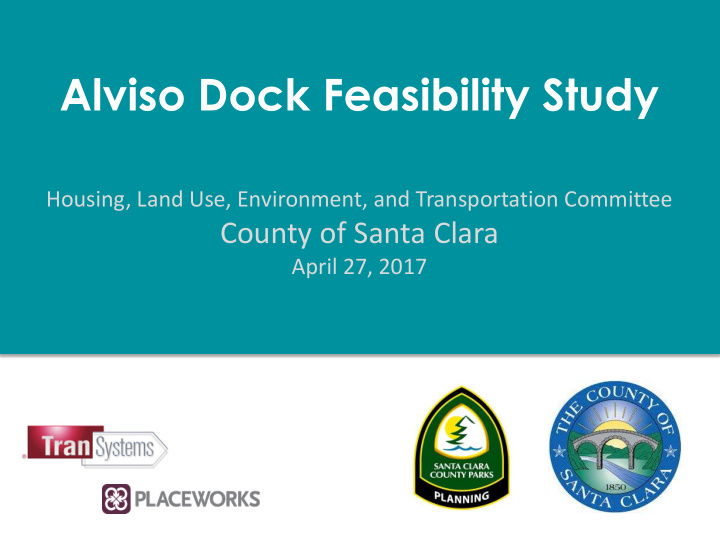



Alviso Dock Feasibility Study Housing, Land Use, Environment, and Transportation Committee County of Santa Clara April 27, 2017
Background & Purpose Background August 2015: Community recommended replacing dock, HLUET directed County Parks to undertake feasibility study June 2016: BOS allocated funding for feasibility study December 2016: Consultant team began preliminary research March 2017: Feasibility Study completed Purpose Assess possibility of replacing the existing Alviso dock Determine associated potential costs, required permits, and potential timeline Determine possibility of opening the dock for public use following its reconstruction
Feasibility Study Approach Background Research Site Analysis Stakeholder Interviews » South Bay Yacht Club (SBYC) » Santa Clara Valley Water District (SCVWD) » State Lands Commission (SLC) » U.S. Army Corps of Engineers (USACE) » SF Bay Conservation and Development Commission (BCDC) Analysis of Project Alternatives
Related Projects, Reports & Plans South San Francisco Emergency Port Study South Bay Salt Ponds Restoration Project South San Francisco Bay Shoreline Study Alviso Slough Restoration Project (SCVWD) » Intended to restore channel width and wildlife habitat to pre-1983 conditions » Estimated to cost over $22 million » USACE denied Clean Water Act Permits (2012)
Potential Project Alternative Scenarios
Existing Alviso Dock Located 0.2 miles south of Alviso County Park boat launch 50 boat slips when originally constructed 8 boat slips remain usable (result of sedimentation) Ownership and Leases: » SLC owns waterway » SCVWD owns land area of dock » SBYC owns a portion of dock; has leases on remainder
Dock Replacement & Landside Facilities Construct 740 feet of new dock for 18 berths ADA-compliant gangway and access Utility infrastructure connections for electrical, water, communications, and sewage Landside amenities: Parking and Restroom Removal of all existing docks, piling, and abandoned boats * All improvements identified above would apply to the potential project. Variations are possible and are expressed in the 3 Alternatives.
SBYC Proposed Project Improvements
SBYC Proposed Project Improvements
Alternatives Considered Alternative 1: Replace Dock; Dredging near Potential Dock Performed by Another Entity Alternative 2A: Replace Dock; No Dredging in Potential Dock Area Alternative 2B: Dock Replacement and Dredging included in project
Opportunities, and Constraints
Potential Project Benefits (All Alternatives) Increase opportunities for water-oriented recreation in the South Bay » Utilize desirable location for recreation (access and connectivity) » Add another South Bay dock to the Bay Water Trail » Improve emergency response access to South Bay waters Nearby vacant lots could support a public staging area
Key Constraints (All Alternatives) Restoration of current sediment-filled dock Multiple land and water-rights owners Emergency response limited by 4-mile journey to Bay (water) and railroad crossings (land) Utilization of a public dock limited by dock capacity New infrastructure needed (ADA-compliant path, restrooms, parking, sewer connection, lighting, and electricity) Easements and/or acquisitions (for associated facilities) is costly and requires willing property owners Potential environmental impacts (wetlands, Special Status and/or Endangered Species, etc.) Dredging anticipated for all alternatives; environmental and financial constraints may be prohibitive.
Channel Accessibility Existing Slough: » ~50-80’ wide; up to 8’ deep (varies) » Regular occurrences of grounded boats in the project vicinity » Limited visibility (levees, land masses, vegetation) Navigability Requirements: » 75’ wide x 6’deep at the potential dock site South Bay Salt Pond Restoration Project » Breach of Pond A8 may improve or stabilize sedimentation » Continued scour cannot be assumed
Slough Cross Section
Dredging Dredging is assumed necessary for all alternatives » Alternative 1- initial dredging in the potential dock area would be completed by a previous project. » Maintenance dredging of the slough every 5 years Dredged sediment is likely mercury-laden (costly disposal) Potential impacts to the Wildlife Refuge and loss of wetland habitat Project would be null and void if USACE denies permits
Regulatory Permits & Requirements Organization Jurisdiction Permits/Requirements U.S. Army Corps of Engineers Federal Section 404, b1 Alternatives Analysis (USACE) San Francisco Bay Conservation 1. Bay Waters and Development Commission State 2. 100-foot shoreline band (BCDC) California Department of Fish & 1. Streambed Alteration Agreement State Wildlife (CDFW) 2. Endangered Species Consultation* 1. Waste Discharge Requirements Regional Water Quality Control State Board (RWQCB) 2. 401 Water Quality Certification State Lands Commission (SLC) State Lease 1. Lease/ MOA Santa Clara Valley Water District Local 2. Construction & Encroachment Permit US Fish and Wildlife Service Federal Endangered Species Consultation* (USFWS) * The Consultation will determine if a permit will be required by the organization
Approximate Timeline
Approximate Implementation Timeline All alternatives: Estimated 78 months » Channel dredging » Environmental Impact Report (EIR) under CEQA Alternative 1 is dependent on other project(s) In-water work window for sensitive species: June 1st to November 30th
Financial Considerations
Alternatives Cost Comparison
Findings & Recommendations
Findings Feasible from engineering perspective Permits for dredging will be difficult to obtain High capital and ongoing maintenance costs Revenue generation would not cover costs Recommendations Further study would be needed to confirm slough navigability and/or level of dredging required. If dredging is required, no alternatives are recommended for further consideration.
Questions?
Recommend
More recommend